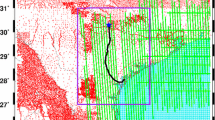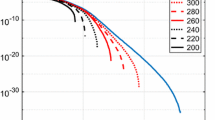Abstract
In precise geoid modelling the combination of terrestrial gravity data and an Earth Gravitational Model (EGM) is standard. The proper combination of these data sets is of great importance, and spectral combination is one alternative utilized here. In this method data from satellite gravity gradiometry (SGG), terrestrial gravity and an EGM are combined in a least squares sense by minimizing the expected global mean square error. The spectral filtering process also allows the SGG data to be downward continued to the Earth’s surface without solving a system of equations, which is likely to be ill-conditioned. Each practical formula is presented as a combination of one or two integral formulas and the harmonic series of the EGM.
Numerical studies show that the kernels of the integral part of the geoid and gravity anomaly estimators approach zero at a spherical distance of about 5°. Also shown (by the expected root mean square errors) is the necessity to combine EGM08 with local data, such as terrestrial gravimetric data, and/or SGG data to attain the 1-cm accuracy in local geoid determination.
Similar content being viewed by others
References
Arabelos D, Tscherning C C 1995: J. Geophys. Res., 100, No. B11, 22009–22015.
Arabelos D, Tscherning C C 1999: Phys. Chem. Earth (A), 24, 19–25.
Bruinsma S L, Marty J C, Balmino G, Biancale R, Förste C, Abrikosov O, Neumayer H 2010: GOCE Gravity Field Recovery by Means of the Direct Numerical Method. Presented at the ESA Living Planet Symposium, Bergen, Norway
ESA 1999: Gravity Field and Steady-State Ocean Circulation Mission, ESA SP-1233(1). Report for mission selection of the four candidate earth explorer missions. ESA Publications Division
Eshagh M 2009: On satellite gravity gradiometry. Doctoral dissertation in Geodesy, Royal Institute of Technology (KTH), Stockholm, Sweden
Eshagh M 2010: Acta Geophys., 59, 29–54.
Freeden W, Michel V 2003: Multiscale Potential Theory, with applications to Geosciences. Birkhäuser Boston, USA
Heiskanen W, Moritz H 1967: Physical geodesy. W H Freeman and Company, San Francisco and London
Janak J, Fukuda Y, Xu P 2009: Earth Planets Space, 61, 835–843.
Kotsakis C 2007: Geophys. J. Int., 171, 509–522.
Metzler B, Pail R 2005: Stud. Geophys. Geod., 49 441–462.
Migliaccio F, Reguzzoni M, Sansò F, Tscherning C C, Veicherts M 2010: GOCE data analysis: the space-wise approach and the first space-wise gravity field model. Proceedings of the ESA Living Planet Symposium, Bergen, Norway
Pail R, Goiginger H, Mayrhofer R, Schuh W D, Brockmann J M, Krasbutter I, Hoeck E, Fecher T 2010: GOCE gravity field model derived from orbit and gradiometry data applying the time-wise Method. Proceedings of the ESA Living Planet Symposium, Bergen, Norway
Pail R, Bruinsma S, Migliaccio F, Förste C, Goiginger H, Schuh W D, Hoeck E, Reguzzoni M, Brockmann J M, Abrikosov O, Veicherts M, Fecher T, Mayrhofer R, Krasbutter I, Sansò F, Tscherning C C 2011: J. Geod., 85, 819–843.
Pavlis N, Holmes S A, Kenyon S C, Factor J K 2008: An Earth Gravitational model to degree 2160: EGM08. Presented at the 2008 General Assembly of the European Geosciences Union, Vienna, Austria
Reed G B 1973: Application of kinematical geodesy for determining the shorts wavelength component of the gravity field by satellite gradiometry. Ohio state University, Dept. of Geod. Science, Rep. No. 201, Columbus, Ohio
Schuh W D, Brockmann J M, Kargoll B, Krasbutter I, Pail R 2010: Refinement of the stochastic model of GOCE scientific data and its effect on the in-situ gravity field solution. Proceedings of the ESA Living Planet Symposium, Bergen, Norway
Sjöberg L E 1980: Gerlands Beitr. Geophys., 89, 371–377.
Sjöberg L E 1981: An. Geophys. 37, 25–30.
Sjöberg L E 1986: Boll. Geod. Sci. Aff. 45, 229–248.
Tapley B, Ries J, Bettadpur S, Chambers D, Cheng M, Condi F, Gunter B, Kang Z, Nagel P, Pastor R, Pekker T, Poole S, Wang F 2005: J. Geod., 79, 467–478.
Tscherning C C 1989: Ricerche Geod. Topog. Fotogr., 5, 139–146.
Tscherning C C, Arabelos D 2011: Gravity anomaly and gradient recovery from GOCE gradient data using LSC and comparisons with known ground data. Proc. 4th International GOCE user workshop, ESA SP-696.
Tscherning C C, Rapp R 1974: Closed covariance expressions for gravity anomalies, geoid undulations and deflections of vertical implied by anomaly degree variance models. Rep. 355, Dept. Geod. Sci. Ohio State University, Columbus, USA
Tscherning C C, Forsberg R, Vermeer M 1990: Methods for regional gravity field modelling from SST and SGG data. Reports of the Finnish Geodetic Institute, No. 90, 2, Helsinki
Xu P 1992: Geophys. J. Int., 110, 321–332.
Xu P 1998: Geophys. J. Int., 135, 505–514.
Xu P 2009: Geophys. J. Int., 179, 182–200.
Wenzel H-G 1981: ZfV, 106, 102–111.
Wenzel H-G 1982: Geoid computation by least squares spectral combination using integral kernels. Presented to Symposium 4b, IAG General Meeting, Tokyo
Author information
Authors and Affiliations
Corresponding author
Rights and permissions
About this article
Cite this article
Sjöberg, L.E., Eshagh, M. A theory on geoid modelling by spectral combination of data from satellite gravity gradiometry, terrestrial gravity and an Earth Gravitational Model. Acta Geod. Geoph. Hung 47, 13–28 (2012). https://doi.org/10.1556/AGeod.47.2012.1.2
Received:
Accepted:
Published:
Issue Date:
DOI: https://doi.org/10.1556/AGeod.47.2012.1.2




